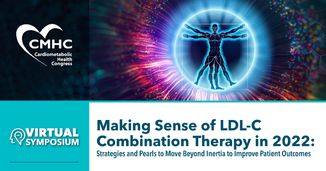Making Sense of LDL-C Combination Therapy in 2022: Strategies and Pearls to Move Beyond Inertia to Improve Patient Outcomes
Supported by an educational grant from Novartis Pharmaceuticals Corporation.
Click Here to Manage Email Alerts

 This activity is jointly provided by Partners for Advancing Clinical Education and Cardiometabolic Health Congress.
This activity is jointly provided by Partners for Advancing Clinical Education and Cardiometabolic Health Congress.
Supported by an educational grant from Novartis Pharmaceuticals Corporation.
Program Overview:
Release Date: February 23, 2023
Expiration Date: February 23, 2024
Lowering LDL-C effectively and safely is paramount to prevent and lower the risk of recurrent ASCVD events. Even with the advances in LDL-C lowering therapy, LDL-C goal achievement is low, and clinical inertia and patient non-adherence are major factors for continued ASCVD residual risk. The landscape of LDL-C lowering therapy is rapidly evolving, with several new and emerging agents that may help address these gaps. In this activity, experts overview the efficacy and safety of these new approaches, how they fit in with the current treatment options for LDL-C lowering, and application to patient care. The information is presented in an easy and digestible format, accompanied by additional resources and suggested readings.
Learning Objectives:
After completing this activity, the participant should be better able to:
- Recognize the need for the early and adequate intensification of LDL-C lowering therapy beyond statins to address ASCVD risk.
- Interpret the data from across major trials and real-world studies with PCSK9 inhibitors and their implications for patient selection.
- Review the new approaches with novel LDL-C lowering agents and their potential impact in ASCVD risk reduction.
- Select individualized treatment strategies for hypercholesterolemic patients that prioritize the early initiation and intensification of therapy to reduce ASCVD risk.
Chair

Christie M. Ballantyne, MD
Center for Cardiometabolic Disease Prevention
Baylor College of Medicine
Houston, TX
Dr. Ballantyne discloses the following:
Grant/Research Support (All paid to institution, not individual): Abbott Diagnostic, Akcea, Amgen, Arrowhead, Esperion, lonis, Merck, Novartis, Novo Nordisk, Regeneron, Roche Diagnostic, NIH, AHA, ADA.
Consultant: 89Bio, Abbott Diagnostics, Alnylam Pharmaceuticals, Althera, Amarin, Amgen, Arrowhead, AstraZeneca, Denka Seiken, Esperion, Genentech, Gilead, lllumina, Matinas BioPharma Inc, Merck, New Amsterdam, Novartis, Novo Nordisk, Pfizer, Regeneron, Roche Diagnostic, Sanofi-Synthelabo

Erin D. Michos, MD, MHS
Associate Professor of Medicine (Cardiology) and Epidemiology
Director of Women’s Cardiovascular Health
Associate Director of Preventive Cardiology
Johns Hopkins University School of Medicine
Baltimore, MD
Dr. Michos discloses the following: Consultant, Advisor, Speaker: AstraZeneca, Bayer, Boehringer Ingelheim, Esperion, Novartis, Novo Nordisk, Pfizer

Joseph Saseen, PharmD
Associate Dean for Clinical Affairs
Professor, Department of Clinical Pharmacy; Professor, Department of Family Medicine
University of Colorado Anschutz Medical Campus
Aurora, CO
Dr. Saseen has nothing to disclose.
JOINT PROVIDERSHIP STATEMENT



In support of improving patient care, this activity has been planned and implemented by Partners for Advancing Clinical Education (PACE) and Cardiometabolic Health Congress (CMHC). PACE is jointly accredited by the Accreditation Council for Continuing Medical Education (ACCME), the Accreditation Council for Pharmacy Education (ACPE), and the American Nurses Credentialing Center (ANCC), to provide continuing education for the healthcare team.
PHYSICIAN CONTINUING EDUCATION
PACE designates this enduring material for a maximum of 1.25 AMA PRA Category 1 Credits™. Physicians should claim only the credit commensurate with the extent of their participation in the activity.
ABIM MOC
 Successful completion of this CME activity, which includes participation in the evaluation component, enables the participant to earn up to 1.25 MOC points in the American Board of Internal Medicine’s (ABIM) Maintenance of Certification (MOC) program. It is the CME activity provider’s responsibility to submit participant completion information to ACCME for the purpose of granting ABIM MOC credit.
Successful completion of this CME activity, which includes participation in the evaluation component, enables the participant to earn up to 1.25 MOC points in the American Board of Internal Medicine’s (ABIM) Maintenance of Certification (MOC) program. It is the CME activity provider’s responsibility to submit participant completion information to ACCME for the purpose of granting ABIM MOC credit.
NURSING CONTINUING EDUCATION
The maximum number of hours awarded for this Continuing Nursing Education activity is 1.25 contact hours.
Pharmacotherapy contact hours for Advance Practice Registered Nurses will be designated on your certificate.
PHARMACY CONTINUING EDUCATION
PACE designates this continuing education activity for 1.25 contact hour(s) (0.125 CEUs) of the Accreditation Council for Pharmacy Education.
Universal Activity Number - JA4008073-9999-23-054-H01-P.
Type of activity: Application
DIETITIAN CONTINUING EDUCATION
This program offers 1.25 CPEUs for dietitians.
Instructions for Participation
In order to receive credit, participants must complete the activity in its entirety. Participants must also score at least an 75% on the posttest and submit it, along with the credit application and evaluation form.
There are no fees for participating in this activity.
For additional information about the accreditation of this activity, please visit https://partnersed.com
DISCLOSURES
The PACE planners and others have no relevant financial relationship(s) to disclose with ineligible companies. The CMHC planners and others have no relevant financial relationship(s) to disclose with ineligible companies.
DISCLOSURE OF CONFLICT OF INTEREST
PACE requires instructors, planners, managers, and other individuals who are in a position to control the content of this activity to disclose all financial relationships they may have with ineligible companies. All relevant financial relationships are thoroughly vetted and mitigated according to PACE policy. PACE is committed to providing learners with high-quality accredited CE activities and related materials that promote improvements or quality in healthcare and not a specific proprietary business interest of an ineligible company.
DISCLOSURE OF UNLABELED USE
This educational activity may contain discussion of published and/or investigational uses of agents that are not indicated by the FDA. The planners of this activity do not recommend the use of any agent outside of the labeled indications. The opinions expressed in the educational activity are those of the faculty and do not necessarily represent the views of the planners. Please refer to the official prescribing information for each product for discussion of approved indications, contraindications, and warnings.
DISCLAIMER
Participants have an implied responsibility to use the newly acquired information to enhance patient outcomes and their own professional development. The information presented in this activity is not meant to serve as a guideline for patient management. Any procedures, medications, or other courses of diagnosis or treatment discussed or suggested in this activity should not be used by clinicians without evaluation of their patient’s conditions and possible contraindications and/or dangers in use, review of any applicable manufacturer’s product information, and comparison with recommendations of other authorities

